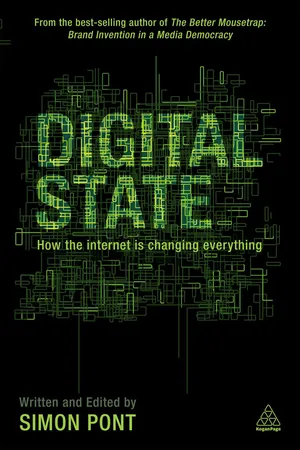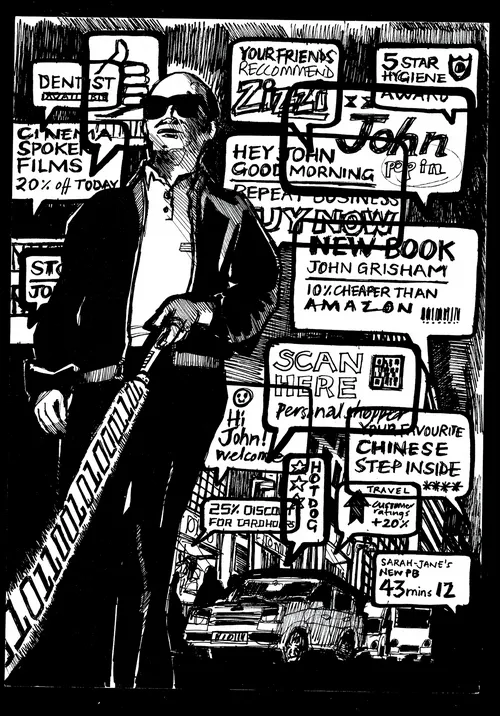![]()
1
DIGITAL CURRENTS AND INVISIBLE FUTURES
Faris Yakob
It wasn’t until ‘creation’ was whittled down to 140 characters and clipped fragments of the web, as with Twitter and Tumblr, that it became obvious that everyone was talking and sharing – and that people were expecting everything else to move in sympathy…
The key thing is for brands to listen to what people are saying and then incorporate that into their content and behaviour, thus demonstrating an understanding that media is one system of interoperating parts…
We can entirely reverse the polarity of advertising media. Rather than trickle-down television, we build up from fragments of many conversations, crafting broadcast stories around real people.
I’d like you to meet… Faris Yakob.
Faris Yakob looks quite a lot like a cycle courier. Y’know, kinda wild and crazy-haired and in perpetual motion, zigging and zagging in and out of downtown traffic, playing chicken with taxis and 10-ton trucks, going head to head with the kind of purpose that suggests he’ll always come off best, as though he has an inside track on some strand of voodoo physics. Faris looks this way even when he’s sitting perfectly still. Maybe it’s the dreadlocks, arguably untypical on a short white guy who read English at Lady Margaret Hall, Oxford – and I do confess to having wondered whether those locks possess a kind of latter-day Samson-like strength of intellect.
So maybe Faris’s hair is somehow connected to the cosmos; maybe he can metaphysically pass through a steel wall of urban gridlock; maybe his thought patterns do mimic the speed and agility of a Tron light cycle – maybe, just maybe. Speculations aside, what I do know is this. Faris is an original, an original thinker, an original piece of work, because you can divide, define and tag the world in any number of ways but, if you run the dividing line simply between those who have questions and those who attempt the answers, it’s not much of a brain-teaser to work out on which side Faris Yakob falls.
*
REM’s ‘The Great Beyond’ was in praise of the late comedian Andy Kaufman, an oddball genius ‘looking for answers from the great beyond’. I think Faris Yakob knows a thing or two about the great beyond, and I’ve always been an applauding fan of the answers he brings back with him. Answers, possibilities, possible futures, that’s what Faris’s chapter is all about.
Just imagine you’re riding pillion on Faris’s light cycle, navigating at speed through the inner workings of his brain – because ‘Digital currents and invisible futures’ fizzes and jumps with thoughts and ideas. It comes at you fast, and merits a double reading. On the first pass, I’d suggest, just roll with it. On the second pass, start wrestling it. ‘Media is one system’, the ‘digital exhaust’, the ‘invisible web’ – to steal a word that Faris is fast making his own, these ideas are pretty awesome, and they’re both fun and exciting to spend some time with.
It made me think of some kind of organic Swiss watch, where everything is an interconnected and delicate moving part – only, then add a new part, and the watch completely changes in nature, but crucially it still works. The addition of each new part doesn’t crunch the mechanism; it just redefines the whole, all the time getting more precise, more intricate, more symbiotic, closer to sentient even – and also, don’t let me forget, invisible.
Over to Faris.
THESIS – WELCOME TO THE DIGITAL STATE
The Digital State is social, local, mobile and personal. The future of digital is infinite, invisible, interactive and intelligent. The future of digital marketing is participatory, frictionless, stimulus, solutions, systems and sales. The future is not the present, but is contained therein.
PROSPECTION
Any attempt to look to the future is usually flawed. When we project ourselves forward, the imagined results are always tainted by our present feelings and concerns – we are unable, imaginatively, to feel any different. This has been the case throughout the history of futurology. The bias of presentism ensures that the novelty of the future is always underestimated. And yet, we know this. The economics of cultural production has radically decentralized. This effect is ongoing, as caused by the proliferation of communication and creation technologies. By consequence, the traditional communications and marketing equilibrium is fundamentally unbalanced.
We are all witnesses, and most of us are participants: content scarcity has given way to content overload, fixed channels of communication have dissolved into fluid and complex networks of information exchange, and once-captive audiences have now become active participants in a largely consumer-driven conversation. This shift requires a new course of action for brands; it demands new marketing imperatives. The answer does not lie in social media alone, or in what social media marketing is purported to be. The solution lies in understanding changing behaviours, patterns of communication and modes of living that the social web merely illuminates. The Digital State is not locked to a screen; it is the redefinition of boundaries between people, institutions and ideas. We must adapt and apply new thinking, skills and methodologies based on these insights.
BECAUSE MEDIA IS A SYSTEM
The Digital State has dissolved the boundaries between channels. Technology has changed the nature, speed and relative scarcity of media. As well as reminding us that media is inherently social, ‘social media’ has begun to dissolve the delineations that we perceived between channels, driving the ‘socialization’ of mainstream media, and indicating how understanding the mediascape as a system of interoperating real-time parts is the model we need today.
BECAUSE MEDIA IS ONE SYSTEM
Kevin Kelly, the founder of Wired and author of What Technology Wants (2007), has long posited the idea of the ‘One Machine’1 – the next step in the evolution of technology, a single platform, with the web as its initial operating system. Every new device simply provides another window into the One Machine. Media could be understood to follow a similar convergent trajectory.
Digital media strips content from the distribution platform, rendering everything as ones and zeros, which means, as all media inexorably becomes ‘digital’ media, all media will be platform agnostic – it flows across what we previously thought of as channels, and different parts of the system can effect change in other parts, in as near as makes no difference to real time.
Up until digitization, making things even more confusing, what we called ‘media’ were themselves assemblages of other things. So ‘television’ isn’t actually a clearly defined thing as such – it’s a socio-cultural construct of a typology of content, a distribution platform and a consumption device. Books, magazines and radio all work the same way. A ‘book’ is a bunch of words printed on paper, with a certain set of culturally defined ideas that float around it.
Up until ‘digitalness’, you couldn’t separate the content from the distribution platform, but in the Digital State ‘content’ can be unbundled from its distribution platform. When IBM started talking about the brave new ‘world of platform agnostic content and the fluid mobility of media experiences’2 in 2006, we weren’t really there yet.
Language, as usual, helps us see where the changes are occurring. When you are watching 30 Rock on Netflix via your Xbox 360, or on Hulu, on a laptop, screen, projector or iPad, are you watching television? If so, why? If not, why not?
Media companies then face the challenge of redefining themselves in a digital world. Previously, they were defined primarily by their distribution platform – a magazine like Vogue is, well, a magazine. In a converged world, Vogue may make videos and put them online, or into an iPad experience – then how are they different to other media companies such as a television station or website publisher?
The Guardian has long been working around this, redefining itself as the ‘World’s leading liberal voice’, a larger proposition than being a daily liberal newspaper in the UK3 – replacing a distribution channel with a global community.
But everyone who works with media, including brands, has to face the same challenge. Online, brands have the opportunity to have direct contact with their customers and prospects. The internet is the great disintermediator, connecting everything to everything else. This opportunity comes at a cost – every brand must function like a content company to maintain the ongoing connection.
THE SOCIALIZATION OF MEDIA
All media are inherently social, in the most literal sense – a medium is a conduit for ideas between people – and in the economic sense. Media have the tendency to operate like solidarity goods – a permanent economic class of goods that get more valuable the more they are consumed.
‘Social media’ – that which is created by the many, rather than the few – has been a long time coming. Henry Jenkins established the blurring of media modalities in 2006:4 in a digital world of democratized creative tools and access, everyone who consumes can create, and everyone who receives can broadcast. But it wasn’t until ‘creation’ was whittled down to 140 characters and clipped fragments of the web, as with Twitter and Tumblr, that it became obvious that everyone was talking and sharing – and that people were expecting everything else to move in sympathy. In January 2011, Twitter’s new CEO nailed the company’s long-term vision: ‘We want to instantly connect people everywhere to what’s most important to them.’5
The harbinger of the real-time web did more than drive a change to Google’s search and the development of Google Instant. One of the key tenets of the Digital State is that every new channel changes the entire system. So, because YouTube exists, how we think about ‘television’ has to change. Regardless of whether or not your campaign has a digital component, the world does.
The greatest effect of Twitter to the system has been to bring down cultural latency to almost zero. Cultural latency6 is a function of the speed of information as it moves through culture. There is a correlation between the amount of time it takes to distribute something and the amount of time it takes for that thing to have an effect and consequently the amount of time that thing stays relevant ...

